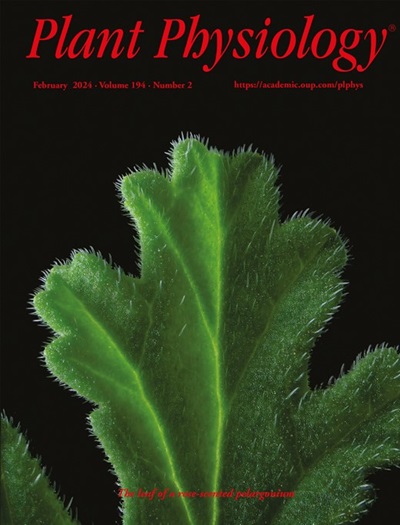An H3K9me2 demethylase encoded by Jumonji C domain-containing DT2 regulates drought tolerance in rice
IF 6.5
1区 生物学
Q1 PLANT SCIENCES
引用次数: 0
Abstract
Drought is a major environmental stress limiting global rice (Oryza sativa) production, emphasizing the vital requirement for understanding the genetic basis of drought tolerance. Here, we identified a Jumonji C (JmjC) domain–containing gene, DROUGHT TOLERANCE 2 (DT2), which encodes an H3K9me2 demethylase that regulates drought tolerance in rice. DT2 reduces the H3K9me2 methylation level at the bZIP transcription factor OsZIP26, thereby increasing its expression. OsZIP26 inhibits the abscisic acid (ABA) biosynthesis gene 9-CIS-EPOXYCAROTENOID DIOXYGENASE 2 (NCED2) by activating the basic helix-loop-helix (bHLH) transcription factor bHLH048. DT2 also interacts with the abscisic acid-stress-ripening-inducible 5 (ASR5) protein. ASR5 directly activates the expression of NCED2, and DT2 impairs the ASR5-mediated activation of NCED2. The suppression of NCED2 reduces endogenous ABA levels, resulting in weak drought tolerance in rice. In addition to identifying DT2 as a negative regulator of drought tolerance, our study highlights the role of this JmjC domain–containing protein in drought tolerance and its potential for breeding drought-tolerant rice cultivars.含有Jumonji C结构域的DT2编码的H3K9me2去甲基化酶调控水稻的抗旱性
干旱是限制全球水稻(Oryza sativa)生产的主要环境胁迫,强调了了解抗旱遗传基础的重要需求。在这里,我们发现了一个含有Jumonji C (JmjC)结构域的基因,干旱耐受性2 (DT2),该基因编码调控水稻抗旱性的H3K9me2去甲基化酶。DT2降低bZIP转录因子OsZIP26的H3K9me2甲基化水平,从而增加其表达。OsZIP26通过激活碱性螺旋-环-螺旋(bHLH)转录因子bHLH048抑制脱落酸(ABA)生物合成基因9-顺式环氧类胡萝卜素双加氧酶2 (NCED2)。DT2还与脱落酸胁迫成熟诱导5 (ASR5)蛋白相互作用。ASR5直接激活NCED2的表达,而DT2则会削弱ASR5介导的NCED2的激活。抑制NCED2降低了内源ABA水平,导致水稻抗旱性弱。除了确定DT2是耐旱性的负调控因子外,我们的研究还强调了这种含有JmjC结构域的蛋白质在耐旱性中的作用及其在选育耐旱水稻品种中的潜力。
本文章由计算机程序翻译,如有差异,请以英文原文为准。
求助全文
约1分钟内获得全文
求助全文
来源期刊

Plant Physiology
生物-植物科学
CiteScore
12.20
自引率
5.40%
发文量
535
审稿时长
2.3 months
期刊介绍:
Plant Physiology® is a distinguished and highly respected journal with a rich history dating back to its establishment in 1926. It stands as a leading international publication in the field of plant biology, covering a comprehensive range of topics from the molecular and structural aspects of plant life to systems biology and ecophysiology. Recognized as the most highly cited journal in plant sciences, Plant Physiology® is a testament to its commitment to excellence and the dissemination of groundbreaking research.
As the official publication of the American Society of Plant Biologists, Plant Physiology® upholds rigorous peer-review standards, ensuring that the scientific community receives the highest quality research. The journal releases 12 issues annually, providing a steady stream of new findings and insights to its readership.
 求助内容:
求助内容: 应助结果提醒方式:
应助结果提醒方式:


